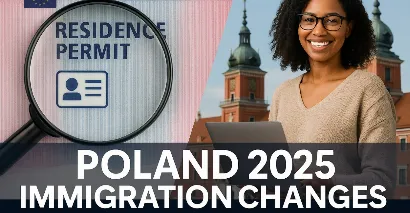Key Highlights
Poland has also transformed its immigration system, with all applications for work permits and employment contracts being strictly online. The nation ceased accepting submissions made in paper indefinitely, and this impacted more than one million foreign workers who are already employed in the country. This change is the most dramatic alteration of the procedure of employment authorization in Poland in decades. Poland has also officially finished the system of work permits done on paper and made it obligatory that all foreign employees and their employers use the online platform provided by the government. This digital revolution impacts the whole range of the Polish immigration system, both seasonal workers on farms and highly proficient experts in the technological and healthcare industries.
Timeline of Digital Implementation
1. Phase One: Special Permissions (July 1, 2025)
Contracts for special permissions and seasonal work permits became the first category requiring mandatory online submission. This phase primarily affected agricultural and temporary workers who traditionally relied on paper-based processes.
2. Phase Two: Standard Work Permits (August 1, 2025)
All standard work permit contracts joined the digital-only requirement. This phase impacted the majority of foreign workers, including those in technology, healthcare, engineering, and service sectors.
|
Contract Type |
Online Deadline |
Affected Workers |
Primary Sectors |
|
Special Permissions |
July 1, 2025 |
150,000+ |
Agriculture, Tourism |
|
Seasonal Work |
July 1, 2025 |
200,000+ |
Construction, Hospitality |
|
Standard Work Permits |
August 1, 2025 |
700,000+ |
IT, Healthcare, Manufacturing |
Also Read: Dummy Ticket for Visa Applicants: Complete Guide
Document Requirements and Digital Signatures
The new system creates a complex landscape regarding document authentication. Polish authorities show inconsistent practices across different regional offices, with some accepting scanned copies of traditionally signed documents while others demand full digital signatures with qualified electronic certificates.
Digital Signature Standards
Poland requires qualified electronic signatures for complete digital processing, following eIDAS regulations. These signatures must be:
-
Uniquely assigned to the signatory
-
Certified through authorized providers listed by Poland's National Certification Centre
-
Valid at the time of signing
Traditional document scanning does not meet Poland's qualified signature requirements. Popular services like DocuSign or similar platforms may not provide the necessary certification level for Polish immigration purposes.
Processing Times and Administrative Impact
Despite the fundamental shift to digital platforms, Polish authorities maintain that processing times will remain largely unchanged. The transition builds on widespread digital adoption that occurred before the mandate, with most applications already submitted electronically prior to the requirement.
-
Work Permit Applications: 30-60 days, depending on permit type
-
Visa Processing: 15-30 days after permit approval
-
Priority Applications: Expedited processing for strategic employers and shortage occupations
Regional Variations in Implementation
Polish regional offices show different behaviour in accepting digital documents. This lack of consistency poses a problem to employers and workers who have to manoeuvre the new system in various voivodeships (administrative areas). Other offices are flexible in terms of taking scanned copies of physically signed contracts; others strictly demand that the entire process be signed digitally. This difference is especially applicable to multinational employers that have operations in many Polish regions.
Also Read: Indian Passport Renewal Document Checklist: Latest Guide
Impact on Foreign Workforce Demographics
The foreign population of the Polish workforce is only getting bigger along with the digitalization. By March 2025 it is projected to have 1.067 million foreign employees, which is a 5.5 percent rise over 2024 levels.
-
Male Employees: 59.9 per cent foreign labour force.
-
Women Employees: 40.1% of the foreign employees.
-
This Employee Category: 405,100 working under mandate agreements.
-
Geographic Concentration: 19.9% in the Warsaw metropolitan area.
Challenges and Compliance Concerns
The mandatory digital system creates new compliance requirements for employers who previously relied on paper-based processes. Companies must update their human resources procedures and ensure access to qualified digital signature systems for both Polish and foreign signatories.
-
Digital Infrastructure: Ensuring reliable internet access and digital literacy
-
Legal Compliance: Meeting qualified signature requirements across international boundaries
-
Document Management: Maintaining digital records and backup systems
-
Cross-border Coordination: Managing signature requirements for workers in different countries
Also Read: How to Write a Letter to the Embassy for a Visa Request? Guide
Conclusion
The mandatory online work permit system in Poland is a fundamental change to the European immigration administration that covers more than a million foreign workers, whilst necessitating extensive digital infrastructures and legal adherence throughout the international borders. It is a policy that paper-based applications no longer exist, which has introduced new challenges and opportunities for employers and workers to navigate a changing digital immigration policy in Poland. For complete details on work permit requirements and application procedures, visit the official Polish government foreigners portal. To know more about Poland's work permit visit TerraTern now!








